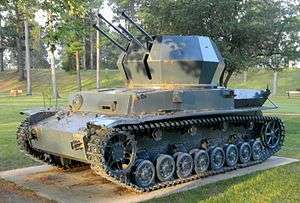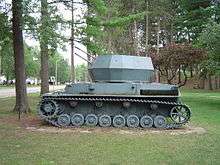Wirbelwind
| Flakpanzer IV "Wirbelwind" | |
|---|---|
 Wirbelwind at CFB Borden | |
| Type | Self-propelled anti-aircraft gun |
| Place of origin | Nazi Germany |
| Specifications | |
| Weight | 22 tonnes (48,501 lbs) |
| Length | 5.89 m (19 ft 4 in) |
| Width | 2.88 m (9 ft 5 in) |
| Height | 2.76 m (9 ft 1 in) |
| Crew | 5 (commander/gunner, two loaders, driver, radio operator) |
|
| |
| Armor | 10–80 mm (.39–3.14 in) |
Main armament | 1 × quad 2 cm Flak 38 |
Secondary armament | 1 × 7.92 mm MG 34 Panzerlauf |
| Engine |
12-cylinder Maybach HL 120 TRM 300 PS (296 hp, 221 kW) |
| Power/weight | 13.6 PS/tonne |
| Payload capacity |
3,200 rounds 2 cm 1,350 rounds 7.92 mm |
| Suspension | Leaf spring |
Operational range | 200 km (124 mi) |
| Speed | 40 km/h (25 mph) |
The Flakpanzer IV "Wirbelwind" (Whirlwind in English) was a German self-propelled anti-aircraft gun based on the Panzer IV tank. It was developed in 1944 as a successor to the earlier Möbelwagen self-propelled anti-aircraft gun.
In the first years of World War II, the German military forces had less interest in developing self-propelled anti-aircraft guns, but as the Allies began to gain air superiority, the need for more mobile and better-armed self-propelled anti-aircraft guns increased. During the early summer of 1944, SS-Hauptsturmführer Karl Wilhelm Krause with the 12th SS Panzer Division Hitlerjugend came up with the concept of the Flakpanzer IV Wirbelwind.[1] He presented the concept to SS-Obersturmbannführer Max Wünsche, commanding officer of the 12th SS Panzer Regiment and it was approved by Hitler.
The Panzer IV's turret was removed and replaced with an open-top, nine-sided turret that housed a quad-barrel 2 cm Flakvierling 38. A closed-top design would have been preferable, but this was not possible due to the heavy smoke generated by the four anti-aircraft guns. The shape of the turret earned it the nickname Keksdose ("Biscuit Tin").[2] Production of the tank was carried out by Ostbau Werke in Sagan, Silesia. However, in combat the 2 cm shells were felt to be insufficiently effective against aircraft, and so a more powerful successor was produced which eventually replaced it. Known as the Flakpanzer IV Ostwind (East Wind), the successor was equipped with a single 3.7 cm Flak 43.[1][3]

The combination of armor and rapid fire from the four guns of the Wirbelwind made it very effective against lightly armoured ground targets such as trucks and armored cars; infantry were particularly vulnerable.[4]
Between 87 and 105 Wirbelwinds were converted from repaired Panzer IV chassis, but due to discrepancies between the recorded production numbers at Ostbau Werke and Wehrmacht service records, the exact number will probably never be known.[1][3]
References
- 1 2 3 "Flakpanzer IV Wirbelwind and Ostwind". Achtungpanzer.com. 18 March 2013. Retrieved 19 June 2014.
- ↑ achtungpanzer.com
- 1 2 Chamberlain, Peter (1999). Encyclopedia of German Tanks of World War II. Cassell. pp. 110–111. ISBN 978-1854095183.
- ↑ Bishop, Chris (2002). The Encyclopedia of Weapons of WWII: The Comprehensive Guide to Over 1,500 Weapons Systems, Including Tanks, Small Arms, Warplanes, Artillery, Ships, and Submarines. Sterling Publishing Company, Inc. pp. 166–167. ISBN 978-1-58663-762-0.
External links
| Wikimedia Commons has media related to Flakpanzer IV Wirbelwind. |
- Panzerworld Wirbelwind specifications
- Achtung Panzer article on Flakpanzer IV
- Surviving Panzer IV variants - A PDF file presenting surviving Panzer IV variants